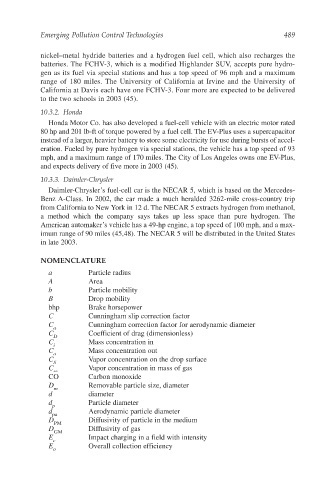Page 522 - Air Pollution Control Engineering
P. 522
12_ch_wang.qxd 05/05/2004 5:27 pm Page 489
Emerging Pollution Control Technologies 489
nickel–metal hydride batteries and a hydrogen fuel cell, which also recharges the
batteries. The FCHV-3, which is a modified Highlander SUV, accepts pure hydro-
gen as its fuel via special stations and has a top speed of 96 mph and a maximum
range of 180 miles. The University of California at Irvine and the University of
California at Davis each have one FCHV-3. Four more are expected to be delivered
to the two schools in 2003 (45).
10.3.2. Honda
Honda Motor Co. has also developed a fuel-cell vehicle with an electric motor rated
80 hp and 201 lb-ft of torque powered by a fuel cell. The EV-Plus uses a supercapacitor
instead of a larger, heavier battery to store some electricity for use during bursts of accel-
eration. Fueled by pure hydrogen via special stations, the vehicle has a top speed of 93
mph, and a maximum range of 170 miles. The City of Los Angeles owns one EV-Plus,
and expects delivery of five more in 2003 (45).
10.3.3. Daimler-Chrysler
Daimler-Chrysler’s fuel-cell car is the NECAR 5, which is based on the Mercedes-
Benz A-Class. In 2002, the car made a much heralded 3262-mile cross-country trip
from California to New York in 12 d. The NECAR 5 extracts hydrogen from methanol,
a method which the company says takes up less space than pure hydrogen. The
American automaker’s vehicle has a 49-hp engine, a top speed of 100 mph, and a max-
imum range of 90 miles (45,48). The NECAR 5 will be distributed in the United States
in late 2003.
NOMENCLATURE
a Particle radius
A Area
b Particle mobility
B Drop mobility
bhp Brake horsepower
C Cunningham slip correction factor
C Cunningham correction factor for aerodynamic diameter
a
C Coefficient of drag (dimensionless)
D
C Mass concentration in
i
C Mass concentration out
o
C Vapor concentration on the drop surface
S
C Vapor concentration in mass of gas
∞
CO Carbon monoxide
D Removable particle size, diameter
m
d diameter
d Particle diameter
p
d Aerodynamic particle diameter
pa
D Diffusivity of particle in the medium
PM
D Diffusivity of gas
GM
E Impact charging in a field with intensity
c
E Overall collection efficiency
o

